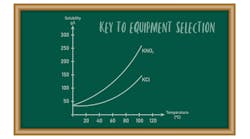Solids Processing: Don’t Fall for Flowability Myths
Flowability testing is expensive, as I mentioned in my November 2017 column (“Conduct Flowability Tests”), but usually pays off in the long run. That being said, in certain situations some simple tests or observations could give results almost as good as an expensive series of evaluations. In that earlier column, I hinted at one case where you could avoid tests when the particle size distribution (PSD) shifted to a larger size. You might wonder how I knew the larger PSD would behave that way. It’s because I understood how flowability testing is conducted: large particles are screened from the samples prior to testing.
A little education goes a long way. It’s important to fully understand not only how to apply the results of a test but also how they were obtained. Here, for instance, the testing firm may not want to speculate on how the large particles will change flowability. It is possible they may bring moisture into the mix and make the mixture sticky. Fortunately, that’s easy to determine without the flowability tests.
A lot of myths about flowability have predominated in solids processing. My favorite is that you can find out how flowable a material is by looking at the angle of repose. First, we must understand what angle of repose is and how it’s determined. If you pour beach sand through a funnel, the slope angle of the pile will be about 35–45°, depending on which beach the sand came from and how you run the test. Keeping the tip of the funnel at the top of the pile as the sand is poured will give a higher angle than if you have a large drop distance. Other common methods of getting angle of repose are to use a tilting box or a rolling cylinder (see Wikipedia); these can give a different angle than that found with a funnel. However, simply using a funnel can provide a handy way to compare an existing material and a new one destined for the same equipment. A significant difference in angle would suggest performing shear testing; its modest cost may prevent expensive production problems in the future.
Another common myth in solids processing is that fluidized solids flow like water. This is correct as long as the solids stay in motion. De-aeration can kill this flow and result in pluggage and segregation. A corollary to this myth is that vibration increases flowability. In fact, vibration often compacts the solids.
Fluidized beds frequently are blamed for attrition — but this is another myth. While particle/particle contact is the main source of attrition and fluidization has a lot of this contact, finer particles take more energy than large particles to break. Also, the fines can act as cushions to breakage. A particulate distribution that follows a Fibonacci sequence is a classic example of this cushioning.
From the early days of pneumatic conveying, the use of long-radius elbows was considered the best way to reduce attrition and pressure drop. This seems logical because the particles would make the turn at a lesser angle and a lower velocity. However, detailed testing of various configurations has shown that particles bounce rather than slide and that dense flow reduces the attrition. One of my plants handled a very abrasive solid and was wearing out long-radius elbows every three months. It switched to short-radius elbows; these lasted only a few more months but were easier to replace and incurred a lower pressure drop. Attrition was insignificant on the product. Another plant welded a plate over a hole generated by abrasion; eventually the abrasion stopped — probably because of cushioning from the dense pocket of solids. Today, a lot of plants use T-elbows or a variation of short-radius elbows to avoid either particle attrition or elbow wear.
Fluidization can be a friend or foe when it comes to blending. In my November 2016 column (“Beware of Blending Myths”), I described the effect of blending time on uniformity. In the example, friction on the particles induced a charge that made the blend less uniform as blend time increased. The style of blender makes a big difference in the amount of aerated and dense material, which can influence the extent of fluidization or flowability. Remember that simpler often is better when looking at flowability of solids.



